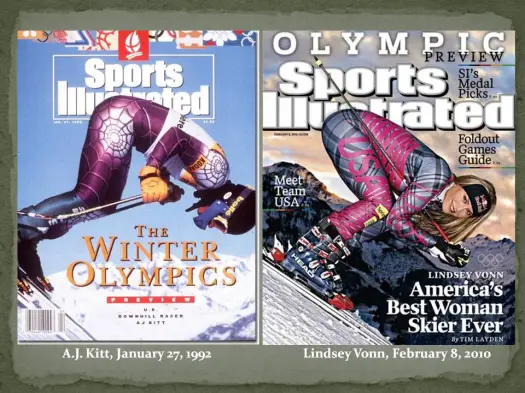Guest Contributors:
Elizabeth Daniels, Ph.D., Assistant Professor, University of Colorado at Colorado Springs
Mary Jo Kane, Ph.D., Director, Tucker Center for Research on Girls & Women in Sport, U of Minnesota
Cheryl Cooky, Ph.D., Associate Professor of American Studies, Purdue University
Nicole M LaVoi, Ph.D., Co-Director, Tucker Center for Research on Girls & Women in Sport, U of Minnesota
Sports Illustrated (SI) recently named Serena Williams its Sportsperson of the Year. As scholars who have spent our academic careers examining media coverage of women’s sports, we are thrilled to see a highly accomplished female athlete awarded this most prestigious title. Considering her on-the-court accomplishments in 2015 Williams is clearly worthy, having won three major tennis titles, amassing an overall 53-3 record, and extending her No. 1 ranking for a third consecutive year. Williams has now joined an elite club of past SI winners: Only 8 other women and one women’s team are in this elite group compared to 68 male athletes or men’s teams. It should be noted that Williams is only the second women of color to be awarded this distinction (track & field star Judi Brown King was the first in 1987). This honor is especially poignant on the heels of Williams’ return to the WTA’s Indian Wells Tournament this past spring after a 13-year boycott of the tournament where she endured racist comments from the audience in 2001 about which tournament organizers did nothing. SI noted her commitment to drawing attention to issues of race in sport was part of why Williams was selected. Serena Williams has proven herself to be a champion time and time again despite discriminatory and harmful distractions leveled at her by sport audiences and media. For example, she was subjected to critiques of her muscularity this summer in an article in The New York Times on body image in sport, which some argued was a thinly veiled commentary regarding black women’s bodies and how they do not fit white, middle-class norms of beauty.

In spite of Williams’ unprecedented accomplishments as arguably the greatest female tennis player in U.S. history, she was featured on the cover in a sexually provocative pose. Perhaps anticipating criticism for such a choice—SI is, after all, a sports not a fashion magazine—they immediately emphasized the point via tweet that this portrayal was Williams’ idea. The choice to feature Williams dressed in an all-black lace bodysuit and patent leather power pumps perched on a throne as Queen of the Court has been supported by some who see this portrayal as empowering. We suggest that there were other choices available to SI and to Williams herself, ones that are not only empowering, but powerful. Unfortunately, such an editorial choice is not new at SI. Anna Kournikova (5 June 2000), Jennie Finch (11 July 2005), and Lindsey Vonn (8 February 2010) have all been portrayed in similarly sexualized ways. Serena Williams herself has appeared in SI’s Swimsuit Issue in 2003. Perhaps not surprisingly, SI has a poor track record when it comes to depicting highly accomplished female athletes outside of the Swimsuit Issue. A recent study of SI covers from 2000-2011 found that women were on only 35 out of 716 covers, and just 11 of those 35 covers showed female athletes in poses comparable to male athletes (2). Clearly, it is a rarity to see a female athlete portrayed as an athletic champion on the cover of this incredibly influential U.S. sports magazine. Regrettably, female athletes are similarly ignored in broadcast media (3). As a result, we fail to see female athletes on any regular basis portrayed as accomplished athletes in mainstream sport media and we have all written previously about how this paucity of coverage negatively impacts interest in women’s sports (4).
Sexualized images of female athletes, in contrast, are not hard to find–simply google ‘female athletes.’ Numerous scholars have also documented that the sexualization of female athletes is a common practice (5). Unfortunately, this is part of a broader pattern wherein girls and women are sexualized in media and popular culture. Three major reports from the UK (6), U.S. (7), and Australia (8) have all documented the prevalence of this practice and its negative consequences on girls and women. When women are sexualized in the media, female viewers may think of their own bodies as objects and reduce their personal value to their physical attractiveness instead of to their talents, personality, and contributions to the world. Our own research has shown that this is precisely how adolescent girls and college women respond to sexualized images of female athletes (9). In addition, sexualized images of female athletes do not generate interest in women’s sports (10). Research also indicates that media images which portray female athletes in powerful action photos generate not only interest in, but respect for, women’s sports. Additionally, after viewing such images teen girls and college-age women are more likely to think about their bodies in terms of their physical skills and capabilities. Portraying sportswomen as gifted and accomplished athletes has the untapped potential to make girls and women feel good about their bodies—which is a significant challenge in today’s media environment inundated with unrealistic and idealized images that create body dissatisfaction.
In an ideal—not to mention realistic—world, images which display female athletes (and their bodies) for what they actually do rather than how sexually empowered they may appear would be easy to come by. If this were the case, girls and young women could have magazine covers of their female sports heroes in their bedrooms as a reminder of what women are capable of and as an equally important reminder that our society values them for what their own bodies can achieve on the court, rather than for how sexually attractive they are. Unfortunately, as Sports Illustrated reminds us, female athletes who dominate their sport are currently only celebrated if they look good doing so.
(2) http://irs.sagepub.com/content/48/2/196.abstract
(3) http://com.sagepub.com/content/early/2015/06/05/2167479515588761.abstract
(5) http://link.springer.com/article/10.1007%2Fs11199-015-0493-x
(6) http://www.ncdsv.org/images/Sexualisation-of-young-people-review_2-2010.pdf
(7) http://www.apa.org/pi/wpo/sexualization.html
(8) http://www.tai.org.au/node/1286







